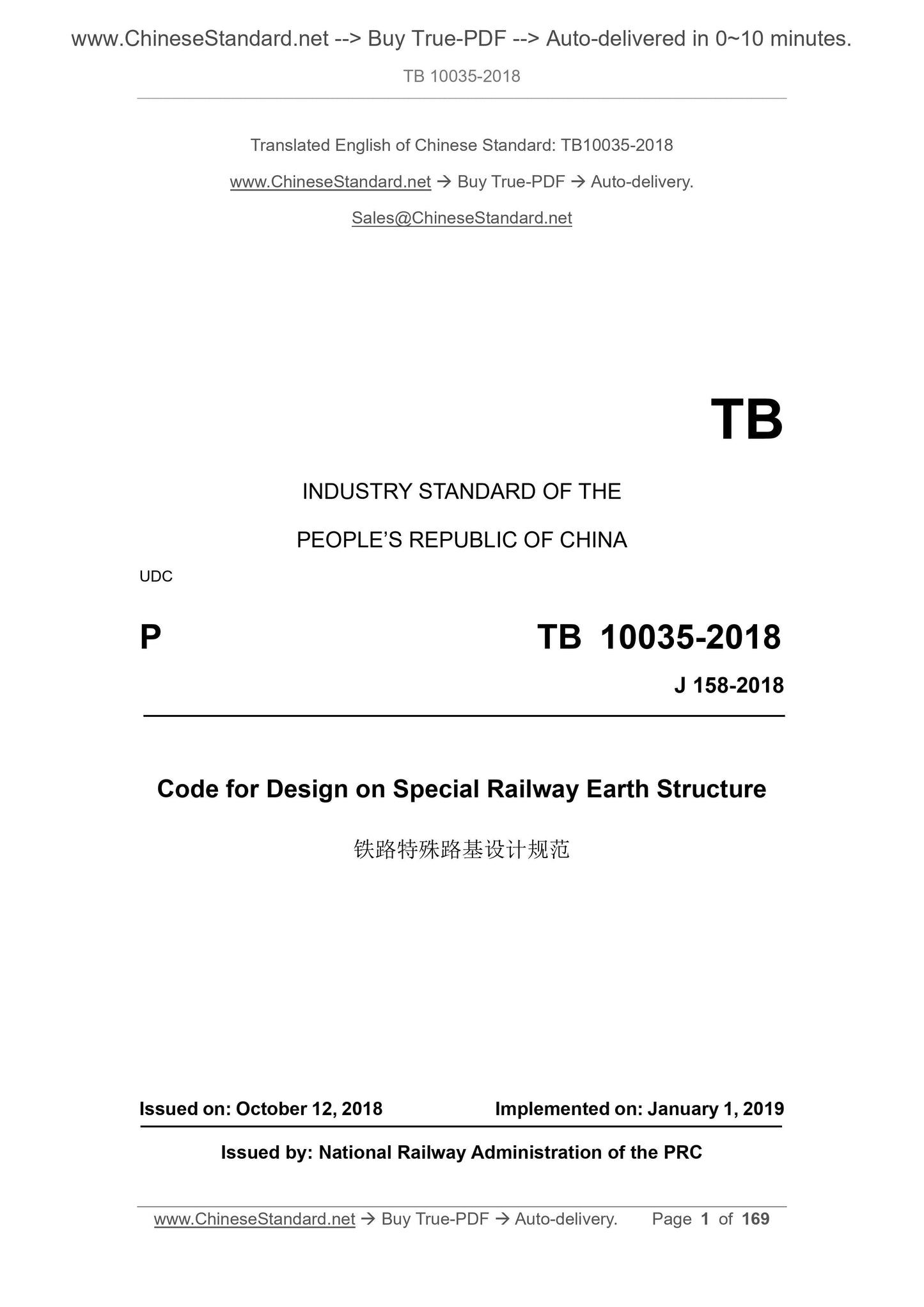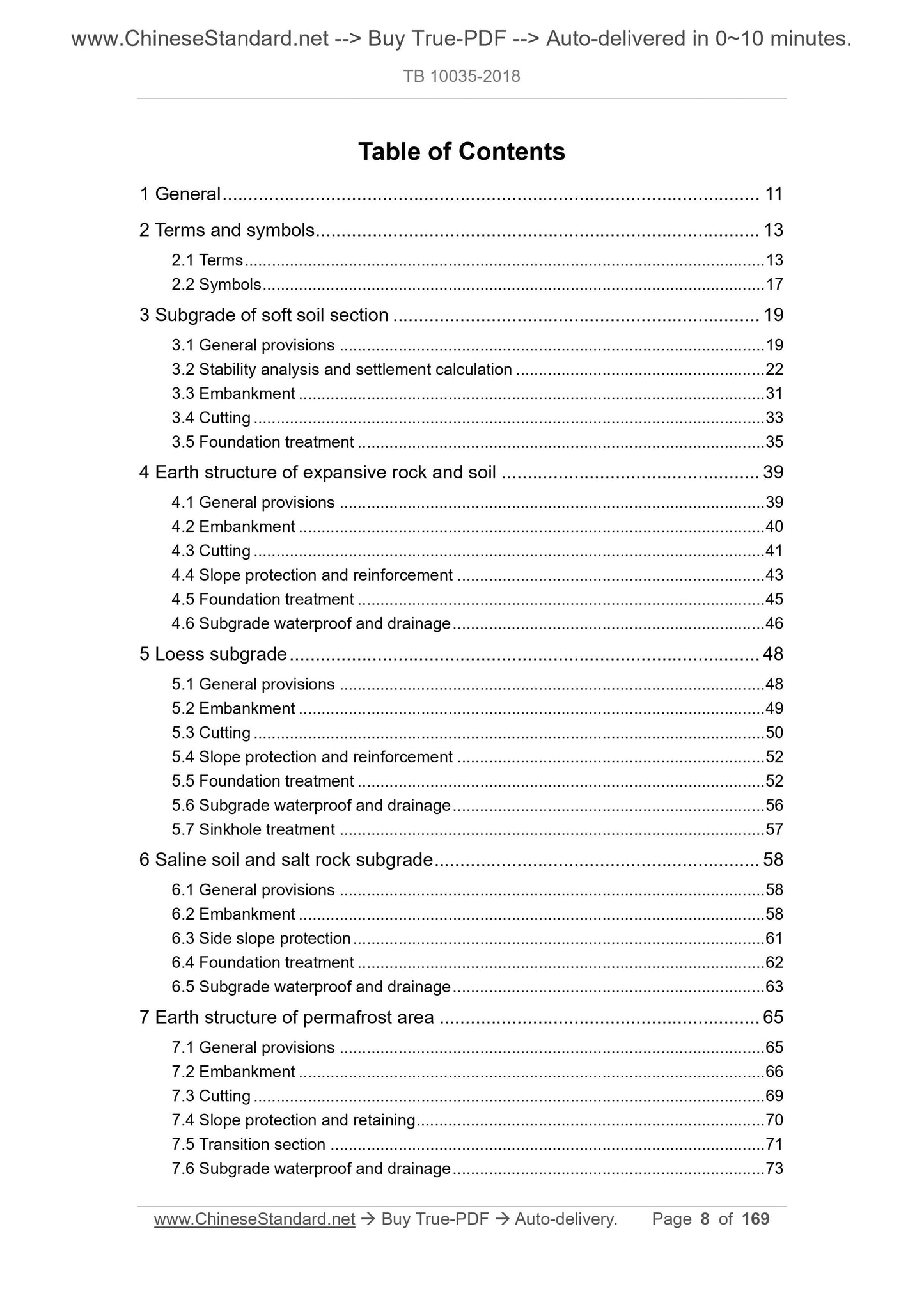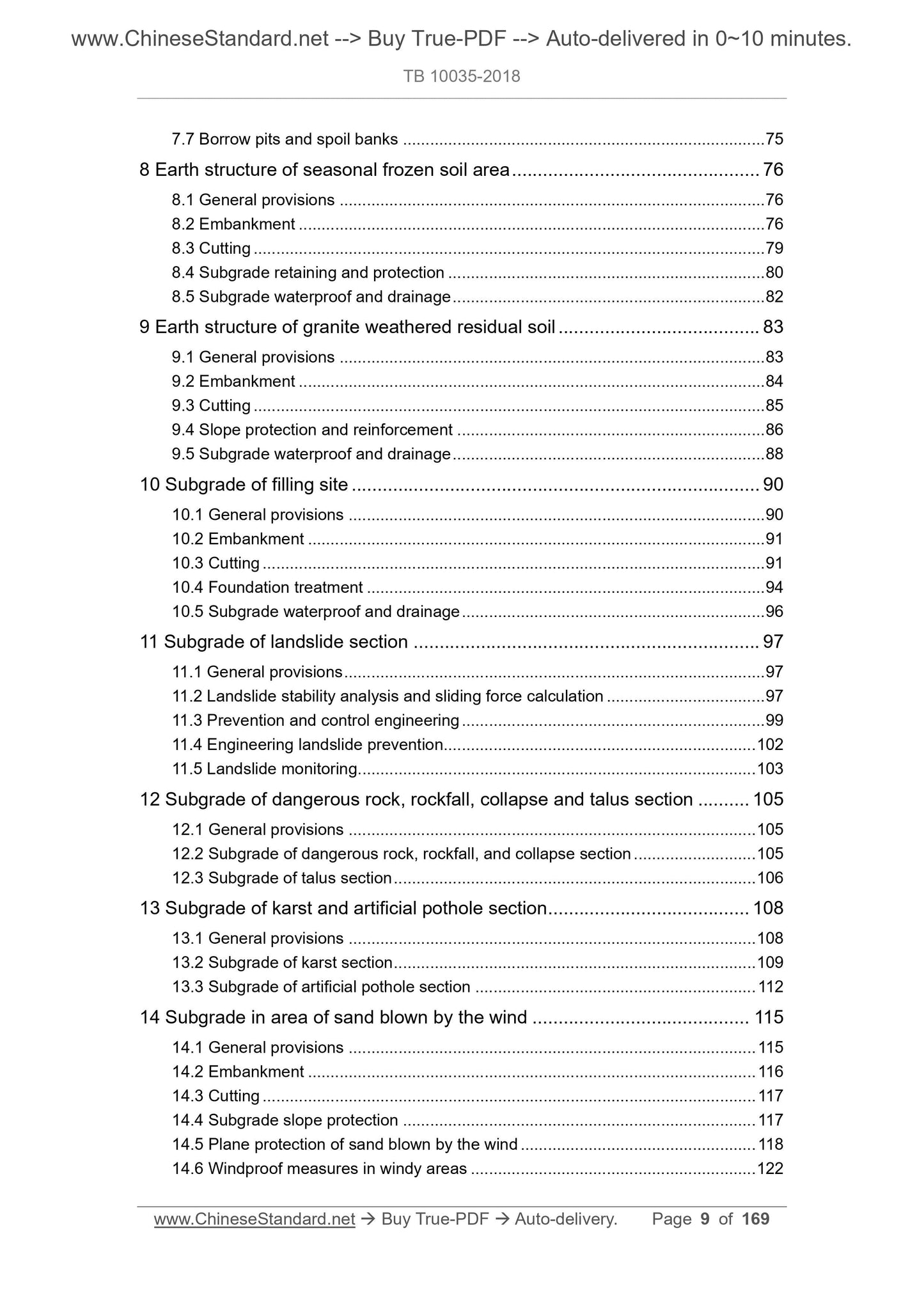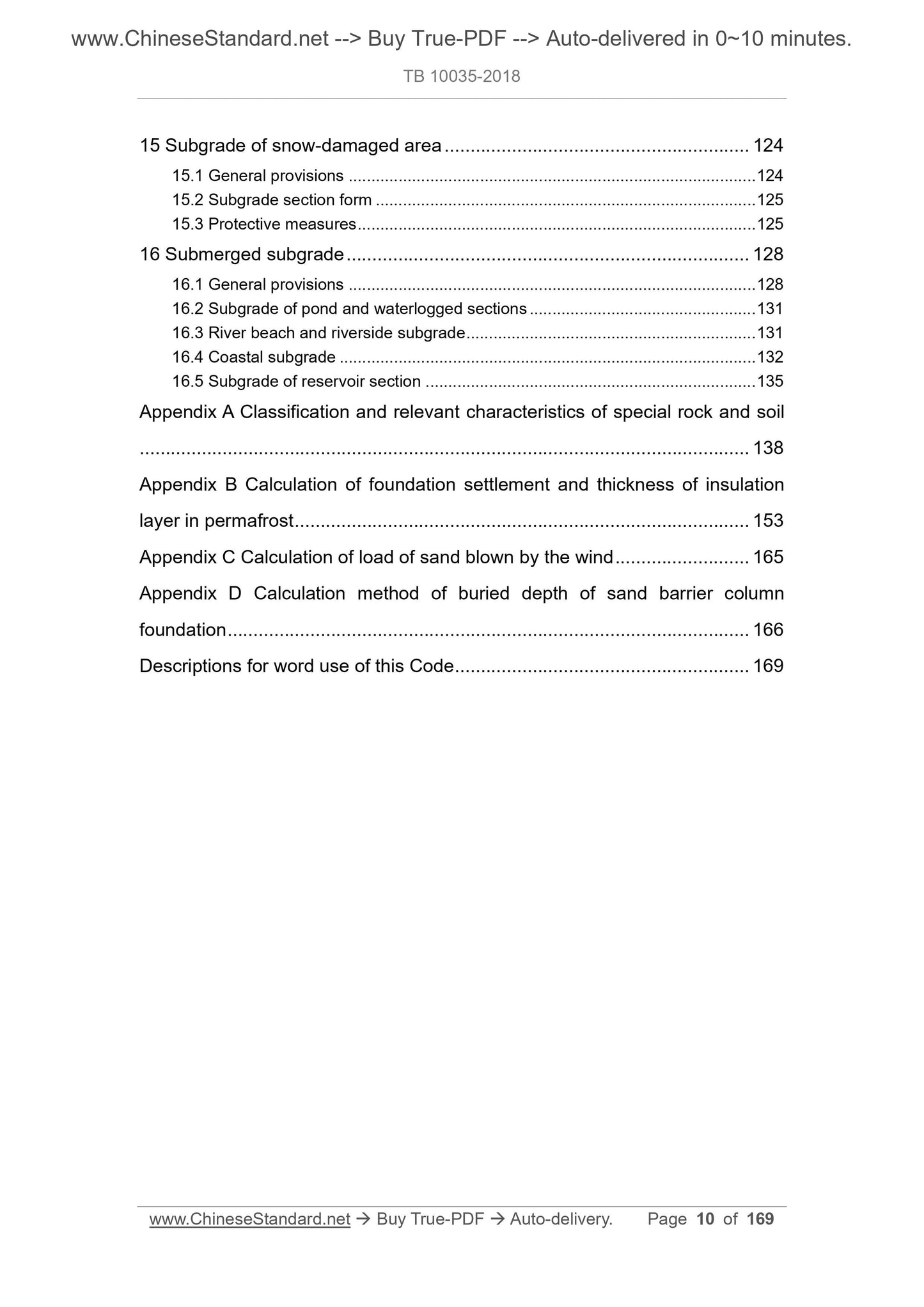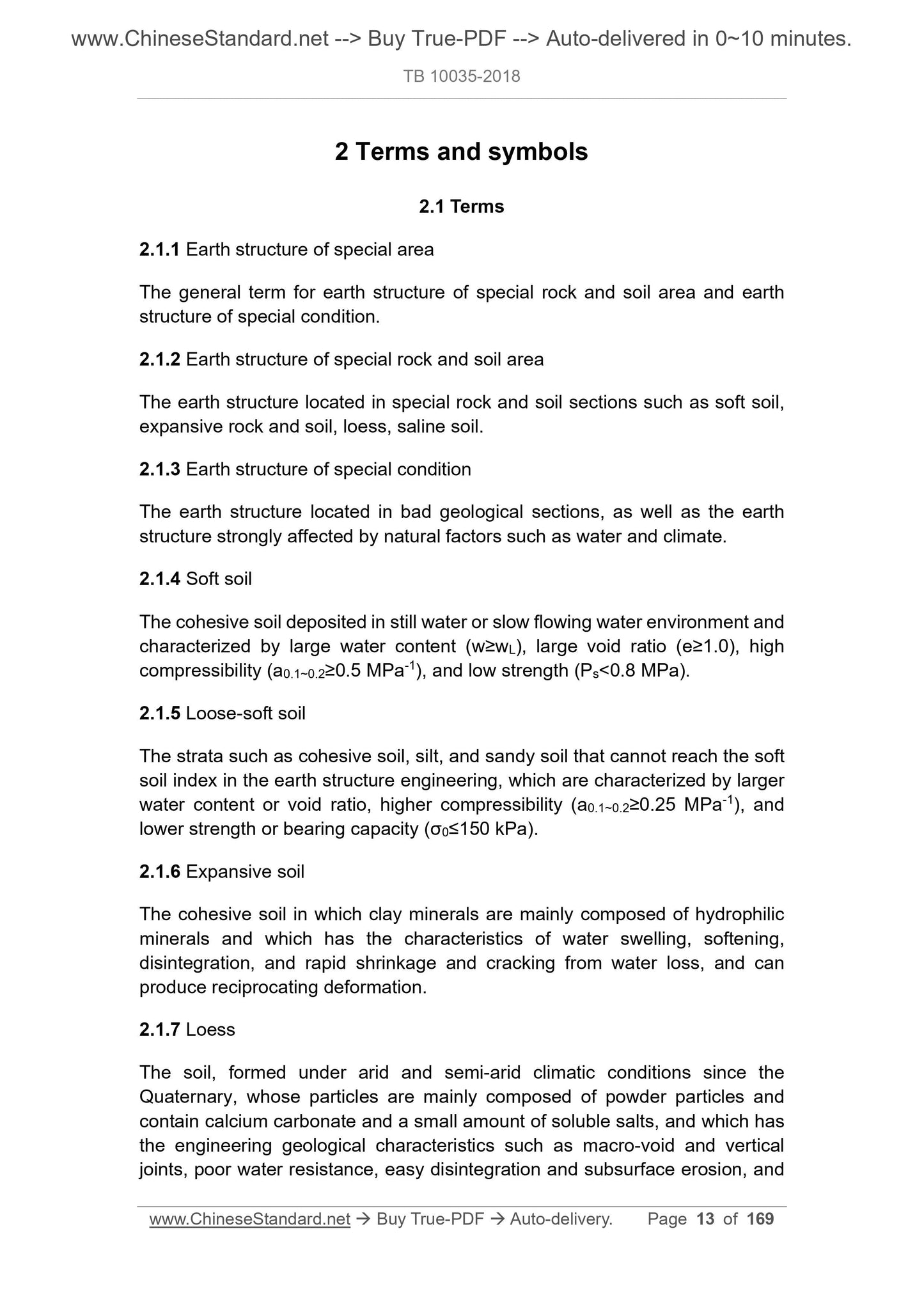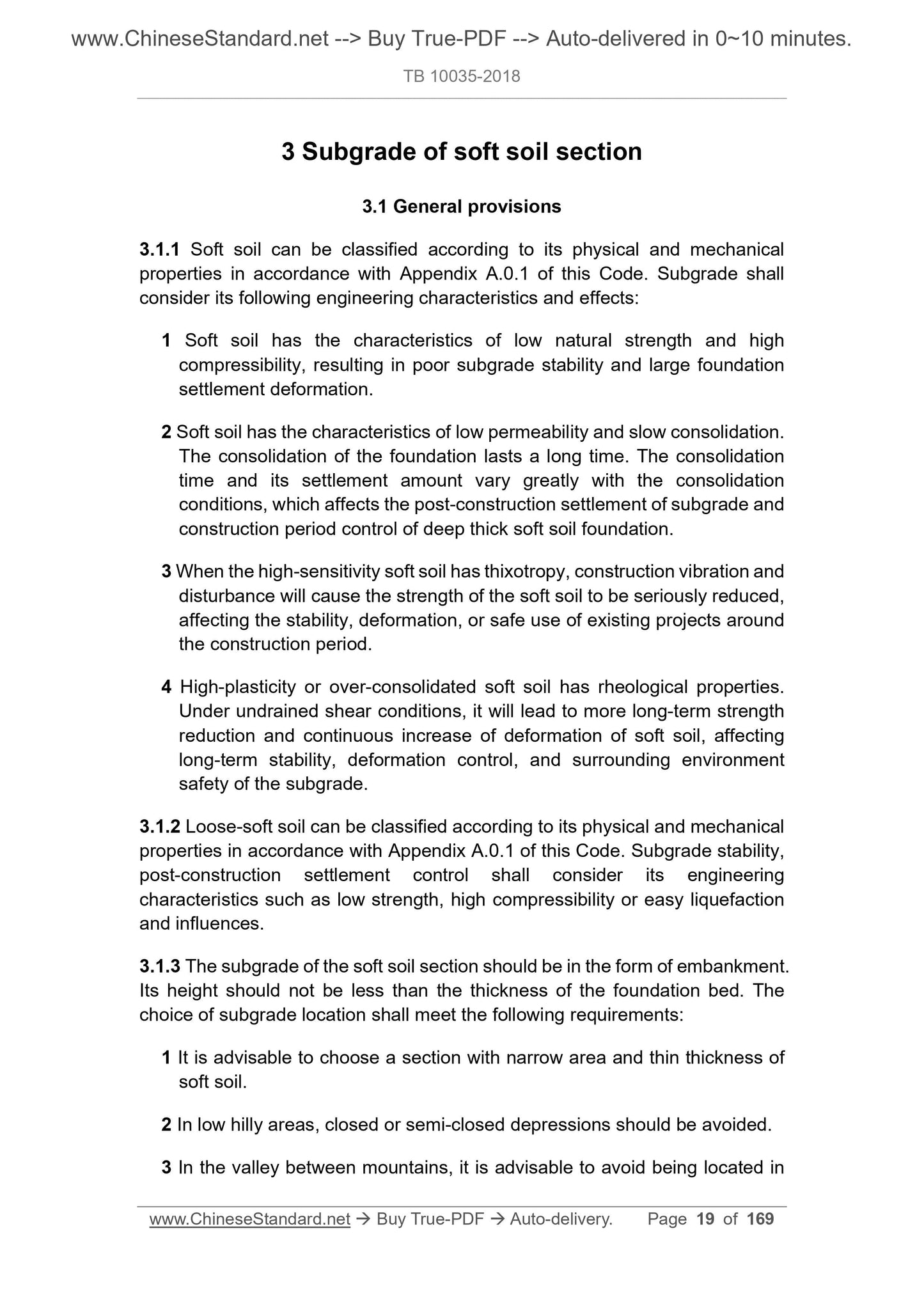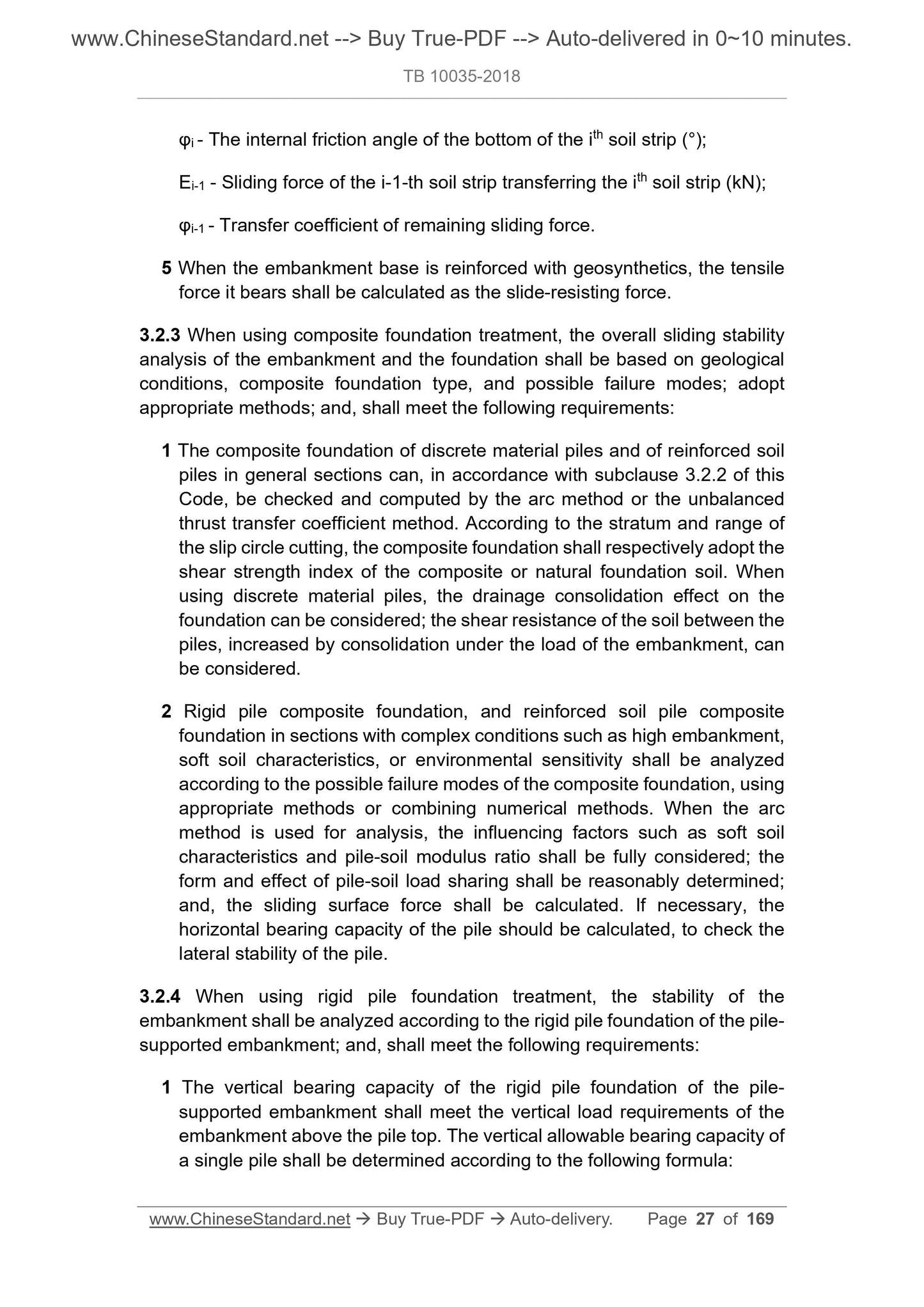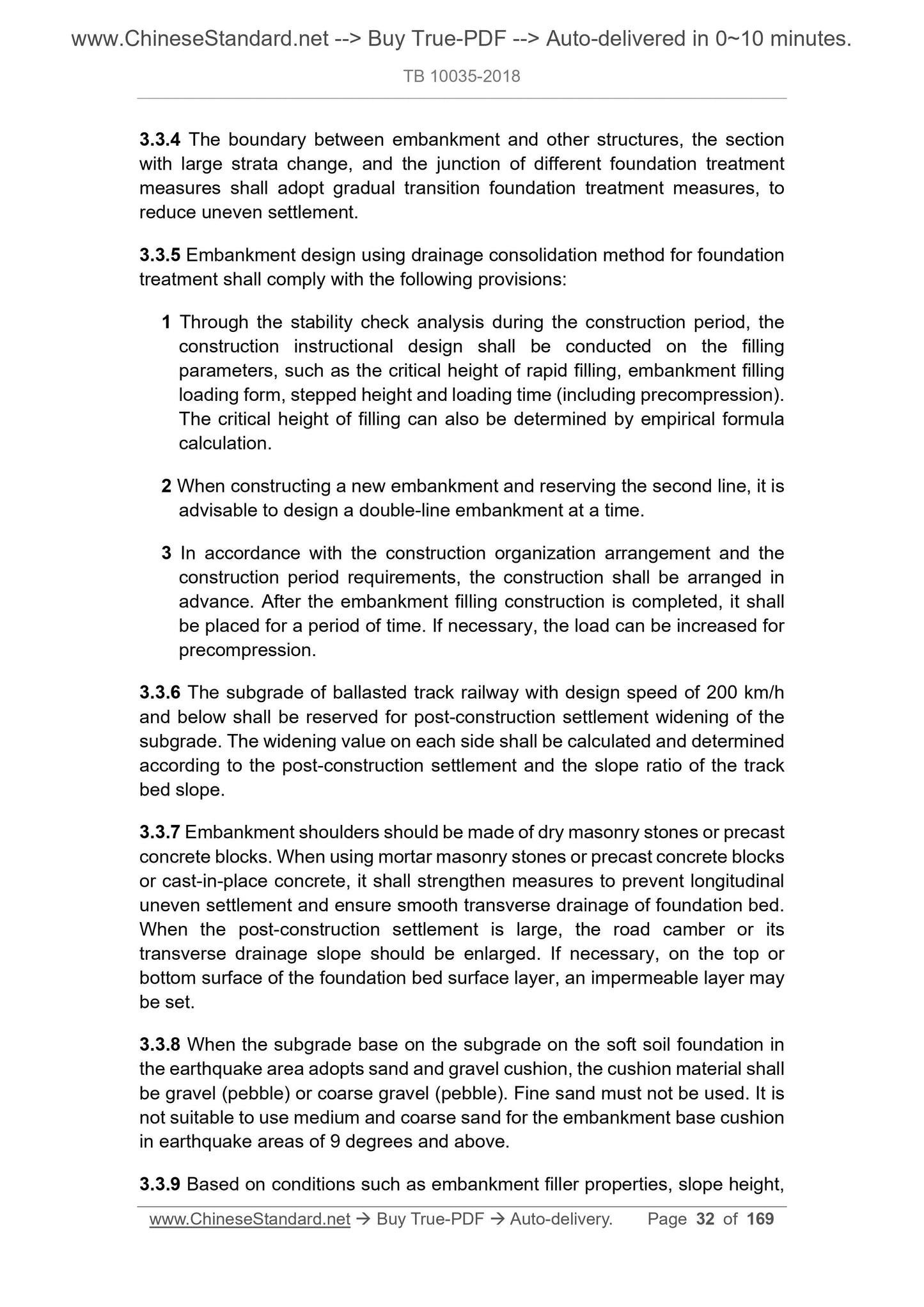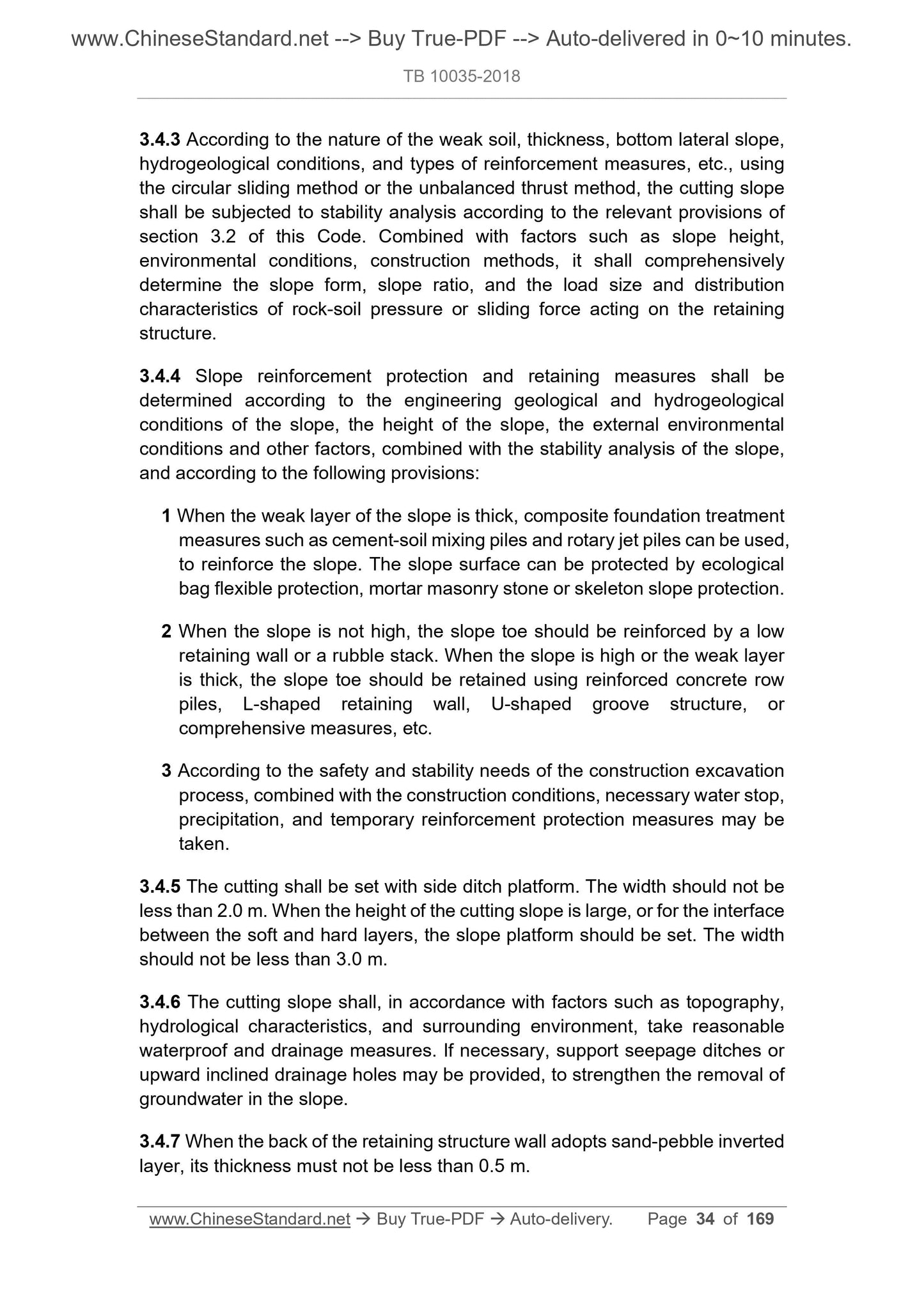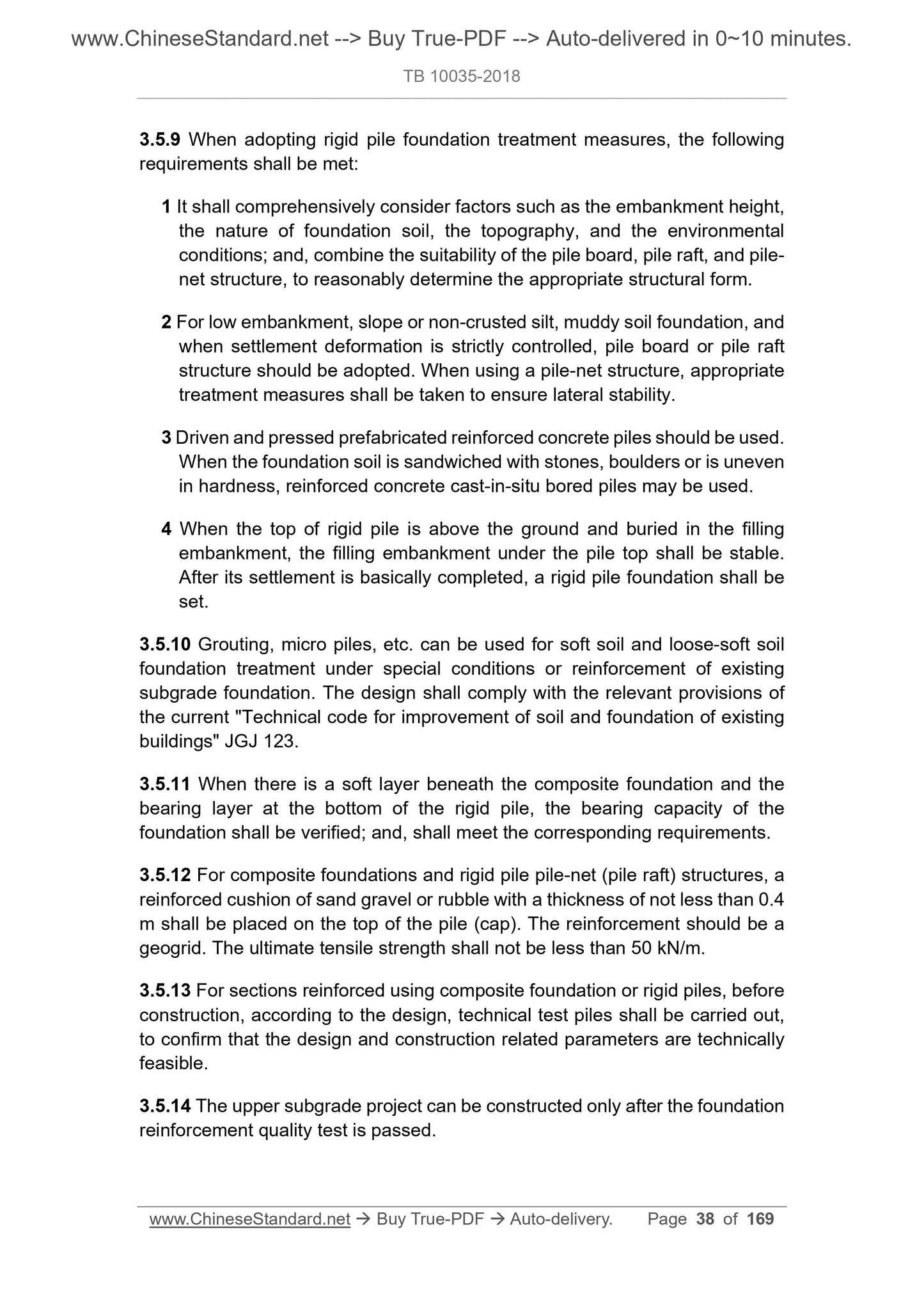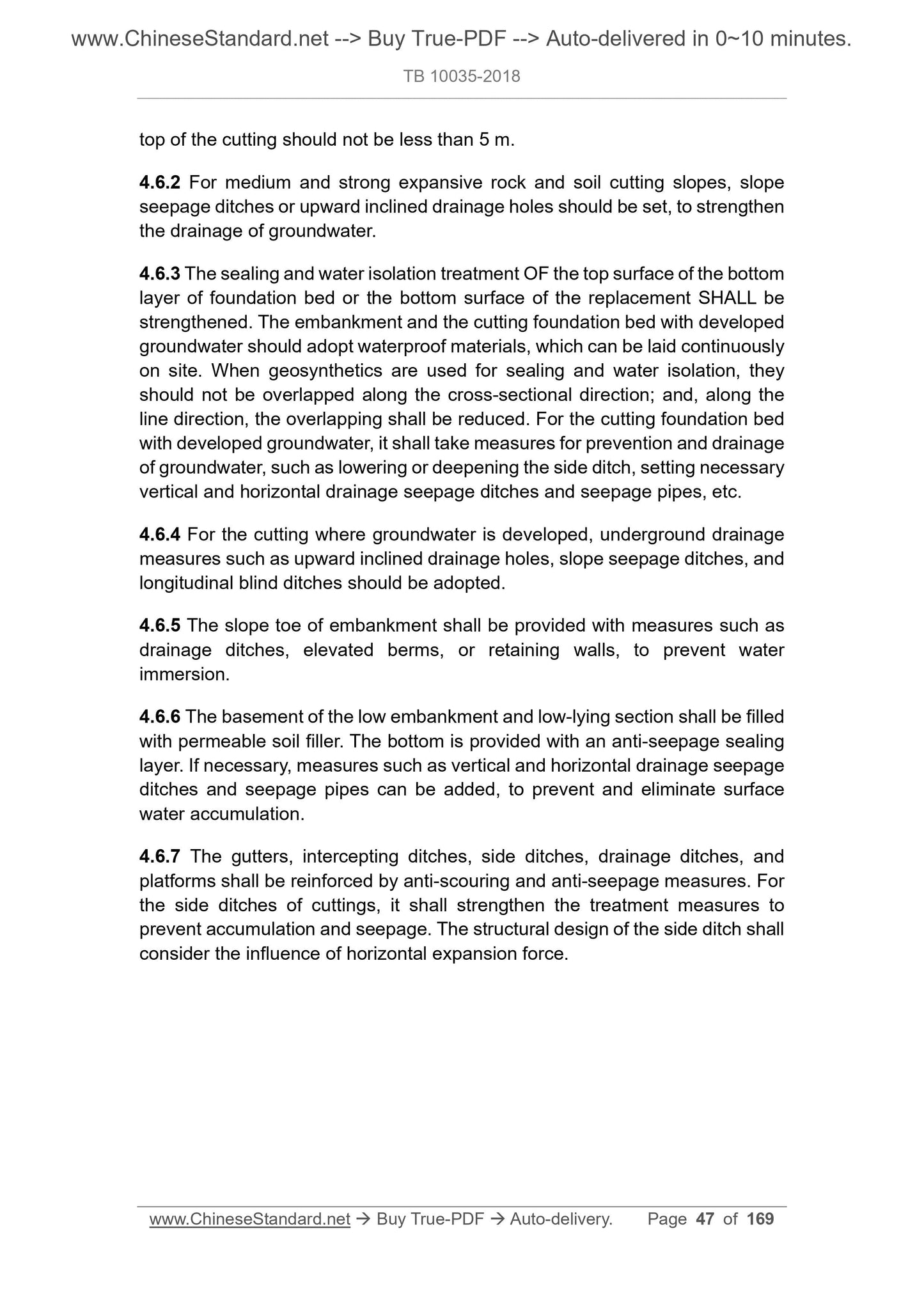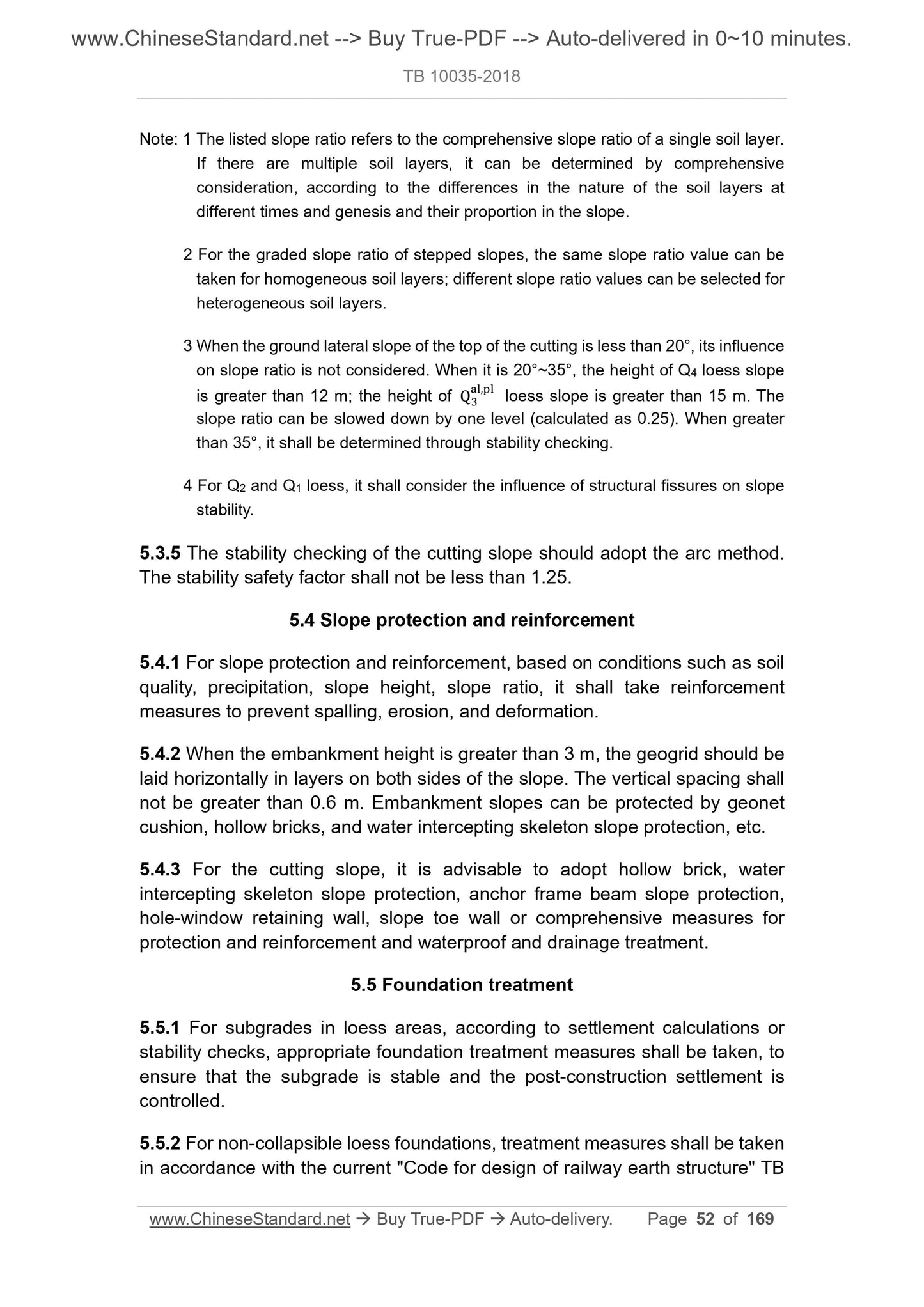1
/
of
12
PayPal, credit cards. Download editable-PDF and invoice in 1 second!
TB 10035-2018 English PDF (TB10035-2018)
TB 10035-2018 English PDF (TB10035-2018)
Regular price
$1,305.00 USD
Regular price
Sale price
$1,305.00 USD
Unit price
/
per
Shipping calculated at checkout.
Couldn't load pickup availability
Delivery: 3 seconds. Download true-PDF + Invoice.
Get QUOTATION in 1-minute: Click TB 10035-2018
Historical versions: TB 10035-2018
Preview True-PDF (Reload/Scroll if blank)
TB 10035-2018: Code for Design on Special Railway Earth Structure
TB 10035-2018
INDUSTRY STANDARD OF THE
PEOPLE’S REPUBLIC OF CHINA
UDC
P TB 10035-2018
J 158-2018
Code for Design on Special Railway Earth Structure
ISSUED ON: OCTOBER 12, 2018
IMPLEMENTED ON: JANUARY 1, 2019
Issued by: National Railway Administration of the PRC
Table of Contents
1 General ... 11
2 Terms and symbols ... 13
2.1 Terms ... 13
2.2 Symbols ... 17
3 Subgrade of soft soil section ... 19
3.1 General provisions ... 19
3.2 Stability analysis and settlement calculation ... 22
3.3 Embankment ... 31
3.4 Cutting ... 33
3.5 Foundation treatment ... 35
4 Earth structure of expansive rock and soil ... 39
4.1 General provisions ... 39
4.2 Embankment ... 40
4.3 Cutting ... 41
4.4 Slope protection and reinforcement ... 43
4.5 Foundation treatment ... 45
4.6 Subgrade waterproof and drainage ... 46
5 Loess subgrade ... 48
5.1 General provisions ... 48
5.2 Embankment ... 49
5.3 Cutting ... 50
5.4 Slope protection and reinforcement ... 52
5.5 Foundation treatment ... 52
5.6 Subgrade waterproof and drainage ... 56
5.7 Sinkhole treatment ... 57
6 Saline soil and salt rock subgrade ... 58
6.1 General provisions ... 58
6.2 Embankment ... 58
6.3 Side slope protection ... 61
6.4 Foundation treatment ... 62
6.5 Subgrade waterproof and drainage ... 63
7 Earth structure of permafrost area ... 65
7.1 General provisions ... 65
7.2 Embankment ... 66
7.3 Cutting ... 69
7.4 Slope protection and retaining ... 70
7.5 Transition section ... 71
7.6 Subgrade waterproof and drainage ... 73
7.7 Borrow pits and spoil banks ... 75
8 Earth structure of seasonal frozen soil area ... 76
8.1 General provisions ... 76
8.2 Embankment ... 76
8.3 Cutting ... 79
8.4 Subgrade retaining and protection ... 80
8.5 Subgrade waterproof and drainage ... 82
9 Earth structure of granite weathered residual soil ... 83
9.1 General provisions ... 83
9.2 Embankment ... 84
9.3 Cutting ... 85
9.4 Slope protection and reinforcement ... 86
9.5 Subgrade waterproof and drainage ... 88
10 Subgrade of filling site ... 90
10.1 General provisions ... 90
10.2 Embankment ... 91
10.3 Cutting ... 91
10.4 Foundation treatment ... 94
10.5 Subgrade waterproof and drainage ... 96
11 Subgrade of landslide section ... 97
11.1 General provisions ... 97
11.2 Landslide stability analysis and sliding force calculation ... 97
11.3 Prevention and control engineering ... 99
11.4 Engineering landslide prevention... 102
11.5 Landslide monitoring ... 103
12 Subgrade of dangerous rock, rockfall, collapse and talus section ... 105
12.1 General provisions ... 105
12.2 Subgrade of dangerous rock, rockfall, and collapse section ... 105
12.3 Subgrade of talus section ... 106
13 Subgrade of karst and artificial pothole section ... 108
13.1 General provisions ... 108
13.2 Subgrade of karst section ... 109
13.3 Subgrade of artificial pothole section ... 112
14 Subgrade in area of sand blown by the wind ... 115
14.1 General provisions ... 115
14.2 Embankment ... 116
14.3 Cutting ... 117
14.4 Subgrade slope protection ... 117
14.5 Plane protection of sand blown by the wind ... 118
14.6 Windproof measures in windy areas ... 122
15 Subgrade of snow-damaged area ... 124
15.1 General provisions ... 124
15.2 Subgrade section form ... 125
15.3 Protective measures ... 125
16 Submerged subgrade ... 128
16.1 General provisions ... 128
16.2 Subgrade of pond and waterlogged sections ... 131
16.3 River beach and riverside subgrade ... 131
16.4 Coastal subgrade ... 132
16.5 Subgrade of reservoir section ... 135
Appendix A Classification and relevant characteristics of special rock and soil
... 138
Appendix B Calculation of foundation settlement and thickness of insulation
layer in permafrost ... 153
Appendix C Calculation of load of sand blown by the wind ... 165
Appendix D Calculation method of buried depth of sand barrier column
foundation ... 166
Descriptions for word use of this Code ... 169
2 Terms and symbols
2.1 Terms
2.1.1 Earth structure of special area
The general term for earth structure of special rock and soil area and earth
structure of special condition.
2.1.2 Earth structure of special rock and soil area
The earth structure located in special rock and soil sections such as soft soil,
expansive rock and soil, loess, saline soil.
2.1.3 Earth structure of special condition
The earth structure located in bad geological sections, as well as the earth
structure strongly affected by natural factors such as water and climate.
2.1.4 Soft soil
The cohesive soil deposited in still water or slow flowing water environment and
characterized by large water content (w≥wL), large void ratio (e≥1.0), high
compressibility (a0.1~0.2≥0.5 MPa-1), and low strength (Ps< 0.8 MPa).
2.1.5 Loose-soft soil
The strata such as cohesive soil, silt, and sandy soil that cannot reach the soft
soil index in the earth structure engineering, which are characterized by larger
water content or void ratio, higher compressibility (a0.1~0.2≥0.25 MPa-1), and
lower strength or bearing capacity (σ0≤150 kPa).
2.1.6 Expansive soil
The cohesive soil in which clay minerals are mainly composed of hydrophilic
minerals and which has the characteristics of water swelling, softening,
disintegration, and rapid shrinkage and cracking from water loss, and can
produce reciprocating deformation.
2.1.7 Loess
The soil, formed under arid and semi-arid climatic conditions since the
Quaternary, whose particles are mainly composed of powder particles and
contain calcium carbonate and a small amount of soluble salts, and which has
the engineering geological characteristics such as macro-void and vertical
joints, poor water resistance, easy disintegration and subsurface erosion, and
3 Subgrade of soft soil section
3.1 General provisions
3.1.1 Soft soil can be classified according to its physical and mechanical
properties in accordance with Appendix A.0.1 of this Code. Subgrade shall
consider its following engineering characteristics and effects:
1 Soft soil has the characteristics of low natural strength and high
compressibility, resulting in poor subgrade stability and large foundation
settlement deformation.
2 Soft soil has the characteristics of low permeability and slow consolidation.
The consolidation of the foundation lasts a long time. The consolidation
time and its settlement amount vary greatly with the consolidation
conditions, which affects the post-construction settlement of subgrade and
construction period control of deep thick soft soil foundation.
3 When the high-sensitivity soft soil has thixotropy, construction vibration and
disturbance will cause the strength of the soft soil to be seriously reduced,
affecting the stability, deformation, or safe use of existing projects around
the construction period.
4 High-plasticity or over-consolidated soft soil has rheological properties.
Under undrained shear conditions, it will lead to more long-term strength
reduction and continuous increase of deformation of soft soil, affecting
long-term stability, deformation control, and surrounding environment
safety of the subgrade.
3.1.2 Loose-soft soil can be classified according to its physical and mechanical
properties in...
Get QUOTATION in 1-minute: Click TB 10035-2018
Historical versions: TB 10035-2018
Preview True-PDF (Reload/Scroll if blank)
TB 10035-2018: Code for Design on Special Railway Earth Structure
TB 10035-2018
INDUSTRY STANDARD OF THE
PEOPLE’S REPUBLIC OF CHINA
UDC
P TB 10035-2018
J 158-2018
Code for Design on Special Railway Earth Structure
ISSUED ON: OCTOBER 12, 2018
IMPLEMENTED ON: JANUARY 1, 2019
Issued by: National Railway Administration of the PRC
Table of Contents
1 General ... 11
2 Terms and symbols ... 13
2.1 Terms ... 13
2.2 Symbols ... 17
3 Subgrade of soft soil section ... 19
3.1 General provisions ... 19
3.2 Stability analysis and settlement calculation ... 22
3.3 Embankment ... 31
3.4 Cutting ... 33
3.5 Foundation treatment ... 35
4 Earth structure of expansive rock and soil ... 39
4.1 General provisions ... 39
4.2 Embankment ... 40
4.3 Cutting ... 41
4.4 Slope protection and reinforcement ... 43
4.5 Foundation treatment ... 45
4.6 Subgrade waterproof and drainage ... 46
5 Loess subgrade ... 48
5.1 General provisions ... 48
5.2 Embankment ... 49
5.3 Cutting ... 50
5.4 Slope protection and reinforcement ... 52
5.5 Foundation treatment ... 52
5.6 Subgrade waterproof and drainage ... 56
5.7 Sinkhole treatment ... 57
6 Saline soil and salt rock subgrade ... 58
6.1 General provisions ... 58
6.2 Embankment ... 58
6.3 Side slope protection ... 61
6.4 Foundation treatment ... 62
6.5 Subgrade waterproof and drainage ... 63
7 Earth structure of permafrost area ... 65
7.1 General provisions ... 65
7.2 Embankment ... 66
7.3 Cutting ... 69
7.4 Slope protection and retaining ... 70
7.5 Transition section ... 71
7.6 Subgrade waterproof and drainage ... 73
7.7 Borrow pits and spoil banks ... 75
8 Earth structure of seasonal frozen soil area ... 76
8.1 General provisions ... 76
8.2 Embankment ... 76
8.3 Cutting ... 79
8.4 Subgrade retaining and protection ... 80
8.5 Subgrade waterproof and drainage ... 82
9 Earth structure of granite weathered residual soil ... 83
9.1 General provisions ... 83
9.2 Embankment ... 84
9.3 Cutting ... 85
9.4 Slope protection and reinforcement ... 86
9.5 Subgrade waterproof and drainage ... 88
10 Subgrade of filling site ... 90
10.1 General provisions ... 90
10.2 Embankment ... 91
10.3 Cutting ... 91
10.4 Foundation treatment ... 94
10.5 Subgrade waterproof and drainage ... 96
11 Subgrade of landslide section ... 97
11.1 General provisions ... 97
11.2 Landslide stability analysis and sliding force calculation ... 97
11.3 Prevention and control engineering ... 99
11.4 Engineering landslide prevention... 102
11.5 Landslide monitoring ... 103
12 Subgrade of dangerous rock, rockfall, collapse and talus section ... 105
12.1 General provisions ... 105
12.2 Subgrade of dangerous rock, rockfall, and collapse section ... 105
12.3 Subgrade of talus section ... 106
13 Subgrade of karst and artificial pothole section ... 108
13.1 General provisions ... 108
13.2 Subgrade of karst section ... 109
13.3 Subgrade of artificial pothole section ... 112
14 Subgrade in area of sand blown by the wind ... 115
14.1 General provisions ... 115
14.2 Embankment ... 116
14.3 Cutting ... 117
14.4 Subgrade slope protection ... 117
14.5 Plane protection of sand blown by the wind ... 118
14.6 Windproof measures in windy areas ... 122
15 Subgrade of snow-damaged area ... 124
15.1 General provisions ... 124
15.2 Subgrade section form ... 125
15.3 Protective measures ... 125
16 Submerged subgrade ... 128
16.1 General provisions ... 128
16.2 Subgrade of pond and waterlogged sections ... 131
16.3 River beach and riverside subgrade ... 131
16.4 Coastal subgrade ... 132
16.5 Subgrade of reservoir section ... 135
Appendix A Classification and relevant characteristics of special rock and soil
... 138
Appendix B Calculation of foundation settlement and thickness of insulation
layer in permafrost ... 153
Appendix C Calculation of load of sand blown by the wind ... 165
Appendix D Calculation method of buried depth of sand barrier column
foundation ... 166
Descriptions for word use of this Code ... 169
2 Terms and symbols
2.1 Terms
2.1.1 Earth structure of special area
The general term for earth structure of special rock and soil area and earth
structure of special condition.
2.1.2 Earth structure of special rock and soil area
The earth structure located in special rock and soil sections such as soft soil,
expansive rock and soil, loess, saline soil.
2.1.3 Earth structure of special condition
The earth structure located in bad geological sections, as well as the earth
structure strongly affected by natural factors such as water and climate.
2.1.4 Soft soil
The cohesive soil deposited in still water or slow flowing water environment and
characterized by large water content (w≥wL), large void ratio (e≥1.0), high
compressibility (a0.1~0.2≥0.5 MPa-1), and low strength (Ps< 0.8 MPa).
2.1.5 Loose-soft soil
The strata such as cohesive soil, silt, and sandy soil that cannot reach the soft
soil index in the earth structure engineering, which are characterized by larger
water content or void ratio, higher compressibility (a0.1~0.2≥0.25 MPa-1), and
lower strength or bearing capacity (σ0≤150 kPa).
2.1.6 Expansive soil
The cohesive soil in which clay minerals are mainly composed of hydrophilic
minerals and which has the characteristics of water swelling, softening,
disintegration, and rapid shrinkage and cracking from water loss, and can
produce reciprocating deformation.
2.1.7 Loess
The soil, formed under arid and semi-arid climatic conditions since the
Quaternary, whose particles are mainly composed of powder particles and
contain calcium carbonate and a small amount of soluble salts, and which has
the engineering geological characteristics such as macro-void and vertical
joints, poor water resistance, easy disintegration and subsurface erosion, and
3 Subgrade of soft soil section
3.1 General provisions
3.1.1 Soft soil can be classified according to its physical and mechanical
properties in accordance with Appendix A.0.1 of this Code. Subgrade shall
consider its following engineering characteristics and effects:
1 Soft soil has the characteristics of low natural strength and high
compressibility, resulting in poor subgrade stability and large foundation
settlement deformation.
2 Soft soil has the characteristics of low permeability and slow consolidation.
The consolidation of the foundation lasts a long time. The consolidation
time and its settlement amount vary greatly with the consolidation
conditions, which affects the post-construction settlement of subgrade and
construction period control of deep thick soft soil foundation.
3 When the high-sensitivity soft soil has thixotropy, construction vibration and
disturbance will cause the strength of the soft soil to be seriously reduced,
affecting the stability, deformation, or safe use of existing projects around
the construction period.
4 High-plasticity or over-consolidated soft soil has rheological properties.
Under undrained shear conditions, it will lead to more long-term strength
reduction and continuous increase of deformation of soft soil, affecting
long-term stability, deformation control, and surrounding environment
safety of the subgrade.
3.1.2 Loose-soft soil can be classified according to its physical and mechanical
properties in...
Share
